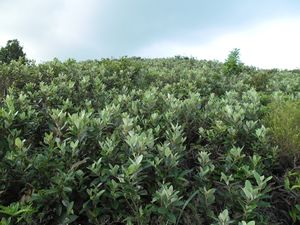Note: This is a project under development. The articles on this wiki are just being initiated and broadly incomplete. You can Help creating new pages.
Rhodomyrtus tomentosa - Rose myrtle
Rhodomyrtus tomentosa is also known as rose myrtle. It is a flowering plant in the family Myrtaceae. It is native to southern and southeastern Asia, from India, east to southern China, Hong Kong, Taiwan and the Philippines, and south to Malaysia and Sulawesi.
Contents
- 1 Uses
- 2 Parts Used
- 3 Chemical Composition
- 4 Common names
- 5 Properties
- 6 Habit
- 7 Identification
- 8 List of Ayurvedic medicine in which the herb is used
- 9 Where to get the saplings
- 10 Mode of Propagation
- 11 How to plant/cultivate
- 12 Commonly seen growing in areas
- 13 Photo Gallery
- 14 References
- 15 External Links
Uses
Diabetes, HIV, Skin damage, Kidney failure, Cancer, Respiratory problems, Burns, Sore throats
Parts Used
Chemical Composition
The 80% ethanol extract from rose myrtle fruit with piceatannol exhibited protection of UVB‑induced cytotoxicity in NHEK; however, piceatannol‑4'‑O‑β‑D‑glucopyranoside exhibited no protection, as determined by a 3‑(4,5‑dimethylthiazol‑2‑yl)‑2,5‑diphenyltetrazolium bromide assay.[1]
Common names
| Language | Common name |
|---|---|
| Kannada | |
| Hindi | |
| Malayalam | |
| Tamil | |
| Telugu | |
| Marathi | NA |
| Gujarathi | NA |
| Punjabi | NA |
| Kashmiri | NA |
| Sanskrit | |
| English | Rose myrtle |
Properties
Reference: Dravya - Substance, Rasa - Taste, Guna - Qualities, Veerya - Potency, Vipaka - Post-digesion effect, Karma - Pharmacological activity, Prabhava - Therepeutics.
Dravya
Rasa
Tikta (Bitter), Kashaya (Astringent)
Guna
Laghu (Light), Ruksha (Dry), Tikshna (Sharp)
Veerya
Ushna (Hot)
Vipaka
Katu (Pungent)
Karma
Kapha, Vata
Prabhava
Habit
Identification
Leaf
| Kind | Shape | Feature |
|---|---|---|
| Simple | Alternate | Mature Foliage is Green, Silver |
Flower
| Type | Size | Color and composition | Stamen | More information |
|---|---|---|---|---|
| Unisexual | 2-4cm long | Yellow | 5 | Flowers Season is June - August |
Fruit
| Type | Size | Mass | Appearance | Seeds | More information |
|---|---|---|---|---|---|
| Berry | 7–10 mm | Mature Fruit Texture is Velvety | Single | {{{6}}} |
Other features
List of Ayurvedic medicine in which the herb is used
Where to get the saplings
Mode of Propagation
How to plant/cultivate
Plants can succeed in tropical and subtropical climates at altitudes up to 2,440 metres.[3]
Commonly seen growing in areas
Often degraded sandy sites, River banks, Riparian zones, At wet forests, Bog margins
Photo Gallery
References
External Links
- Ayurvedic Herbs known to be helpful to treat Diabetes
- Ayurvedic Herbs known to be helpful to treat HIV
- Ayurvedic Herbs known to be helpful to treat Skin damage
- Ayurvedic Herbs known to be helpful to treat Kidney failure
- Ayurvedic Herbs known to be helpful to treat Cancer
- Ayurvedic Herbs known to be helpful to treat Respiratory problems
- Ayurvedic Herbs known to be helpful to treat Burns
- Ayurvedic Herbs known to be helpful to treat Sore throats
- Herbs with Leaves used in medicine
- Herbs with Fruits used in medicine
- Herbs with common name in English
- Habit - Evergreen shrub
- Index of Plants which can be propagated by Seeds
- Index of Plants which can be propagated by Cuttings
- Herbs that are commonly seen in the region of Often degraded sandy sites
- Herbs that are commonly seen in the region of River banks
- Herbs that are commonly seen in the region of Riparian zones
- Herbs that are commonly seen in the region of At wet forests
- Herbs that are commonly seen in the region of Bog margins
- Herbs
- Myrtaceae




